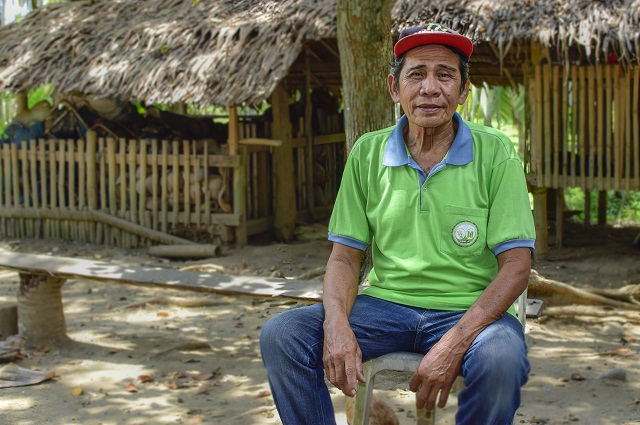Rice farmers tend to change variety every cropping season. Jesus Nibres, 65, of Davao Del Norte considers many factors before trying and planting a specific variety. With almost four decades of experience in rice production, Mang Jesus is keen on recommending varieties. For him, a variety has to be high-yielding, resilient, and resistant to major pests and diseases. All these and more are the characteristics found in Mestiso 20 (M20), a public hybrid that has passed Mang Jesus’ checklist of a reliable variety.
Pleased with Mestiso 20
“Kanindot sa imong humayan uy! [Your rice farm looks perfect!].”
Mang Jesus shares that his fellow farmers kept on appreciating his plots with M20. Since seedling period, he is already amazed because the seedlings of M20 looked very healthy.
Mang Jesus says that the number of tillers and its capability to survive even during strong wind and heavy rain impressed him like no other variety. He repeatedly expressed that the panicles are long and healthy grains are evident.
“People passing along my plots are literally having the ‘wow face’. During grain fruiting period, panicles are bending due to the heaviness of their grains,” he describes.
Mang Jesus harvested 102 cavans per hectare. This is more than 20% higher than his 80 cavans harvest with inbred. In their town, a cavan of unmilled rice is 68-69 kilos per sack and the buying price is P20-21 per kilo. He gains a whooping P70,000 net income or more every time he harvests M20– that is less labor and production cost, and 20 cavans for consumption.
Aside from being high-yielding, M20 has good eating quality. “Unlike other hybrid varieties, M20 have met my expectation when it comes to the softness when cooked. Your grandparents at my age will definitely like it,” he assures.
Handling hybrid
Mang Jesus has planted M20 since 2016. This variety is developed by the Philippine Rice Research Institute (PhilRice) and International Rice Research Institute (IRRI). It yields an average of 6.4 t/ha and can reach as high as 11.7 t/ha. Based on field tests, M20 is moderately resistant to green leafhopper and brown plant hopper.
Mang Jesus noted that a farmer should not be dependent on the plant’s resistance level to pests. “Proper nutrient and water management must be practiced to prevent pests and diseases from reproducing and spreading,” he advises.
“I totally discourage farmers who apply too much fertilizers. It was my practice before until I saw that it doesn’t give good results especially when you are using hybrid seeds,” he adds.
M20 was introduced just recently in his hometown. As the president of their local irrigation association, he kept on encouraging his co-farmers to try this variety. Most of them did and now they always make sure that they get their own M20 seeds from seed dealers every time this variety becomes available.
Commercialization
To encourage the use of public hybrid seeds and increase labor opportunities in hybrid seed production in rural rice growing communities, PhilRice launched the Public Hybrid Rice Commercialization Program (PHRCP). The Institute produces hybrid seed parental of public hybrids.
Public breeding institutions such as PhilRice, University of the Philippines Los Banos, PhilSCAT, and IRRI develop public hybrid rice varieties.
According to Leylani M. Juliano, PHRC program leader, majority of the current areas planted to F1 seed production are confined in Region 2 (Cagayan and Isabela) and CAR (Kalinga) for Mestizo 1 (M1), and Davao provinces for M1 and Mestiso 20 (M20). F1 seeds are first generation seeds produced through cross pollination of two pure lines.
With the increased efforts of promoting public hybrid, the team is expecting to see more seed growers and farmers planting these varieties in the next few years. Data during the first semester of 2018 shows that about 110 hectares were planted to produce the F1 of M1 and 130 hectares were planted to produce the F1 of M20.
“We want to make the growth of hybrid rice as a means to feed the world. However, there are aspects that we need to improve such as in F1 seed production, F1 cultivation, technical capacity of seed growers, and hybrid rice policies on pricing, credit support, and other regulations,” Juliano says.






